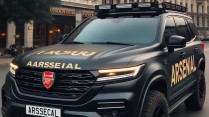Urban Streets Buzz as Robotaxis Reconquer Roads, Safety Concerns Still Exist
By Dabbie Davis
Jun 10, 2024 11:39 PM EDT

In the transportation industry, innovation is changing how people move around. Robotaxis are a new kind of taxi that drives itself without a driver. They first appeared on the streets of cities like San Francisco and Phoenix.
Some people worry about how safe they are and if they can make quick decisions like a human driver. Despite these concerns, many believe robotaxis could revolutionize how we travel in the future.
More Robotaxis Presence in Streets Soon
As humans use technology in making mobility go green, more convenient, and beyond one's imagination a reality, emerges robotaxis. The presence of these driverless cars in the streets cannot be ignored. Infact, the concept has attracted more and more companies to come up with their version model.
Along with the presence comes safety concerns about these robotaxis. As highlighted in an MIT Technology Review report from last year, the involvement of both the public and elected officials is crucial in shaping the trajectory of this emerging technology.
Particularly noticeable in select San Francisco neighborhoods during late-night hours is the proliferation of driverless vehicles on the streets, a sight not of mere testing but of operational robotaxis.
These autonomous cars, operated by Cruise and Waymo, are actively challenging traditional transportation modes like taxis, Uber, and public transit, gradually integrating into the urban mobility landscape of cities such as San Francisco, Austin, Phoenix, and possibly Los Angeles.
The surge of robotaxis continues to unfold, with a notable influx of self-driving vehicles making their way to Central Texas. According to MYSA's report, Amazon's autonomous vehicle division, Zoox, is set to initiate trials of its driverless cars in Austin and Miami, as disclosed in an official statement.
Zoox plans to introduce a test fleet comprising retrofitted Toyota Highlanders equipped with human safety drivers within specific zones near the commercial and entertainment hubs of both urban centers.
This strategic expansion marks Zoox's venture beyond the western United States, positioning Austin and Miami as its fourth and fifth public testing locales following its initial trials in San Francisco back in 2018, subsequently extending its operations to various cities across California, Nevada, and Seattle.
In a recent update from TechCrunch, GM's Cruise is relaunching a limited fleet of robotaxis in Dallas this week, aligning with the company's objective to verify the effectiveness of its autonomous technology and regain public confidence.
This initiative marks Cruise's return to Dallas as the second city where it is gradually reintroducing its services, following the suspension of its entire U.S. fleet last year.
READ MORE: Jamie Chadwick Makes History as First Woman Winning Indy NXT Race Since 2010
The decision to resume operations comes after an unfortunate incident in San Francisco involving a pedestrian being struck and dragged by a Cruise robotaxi, prompting a reevaluation of safety measures and operational protocols.
Safety Concerns Emerge
The report revealed Waymo's initial analysis of its first million miles with passengers revealed two reportable crashes and 18 minor incidents, underscoring the complexity of safety evaluations in this evolving landscape.
While Waymo emphasizes the uniqueness of autonomous driving data compared to human-driven scenarios, Cruise asserts a notable reduction in collision rates for its robotaxis when compared to conventional human ride-hail drivers, suggesting a promising safety record in autonomous operations.
As stated in RAND's report, Senate Bill 915 responds to a series of notable incidents involving Cruise's autonomous vehicles in San Francisco. These events included collisions with a fire truck and an AV incident with a pedestrian.
Following these occurrences, California's Department of Motor Vehicles suspended Cruise's operations across the state in October. In response, the General Motors subsidiary has expressed a renewed commitment to prioritizing "trust, accountability, and transparency.
Moreover, as per RAND's report, Waymo, the autonomous vehicle arm of Alphabet, has established a presence in multiple cities, with operations in San Francisco and a road show underway in Los Angeles.
Notably, in Phoenix, Waymo has collaborated with Uber to offer passengers the option of utilizing driverless transportation services.
The potential benefits of robotaxis and other autonomous vehicles extend beyond convenience, with optimism surrounding their ability to enhance overall road safety and mobility in the future.
RELATED ARTICLE: Vay Unveils Remote-Controlled Car Rental Service in Las Vegas
Copyright @ MOTORTIMES, All rights reserved. Do not reproduce without permission.








